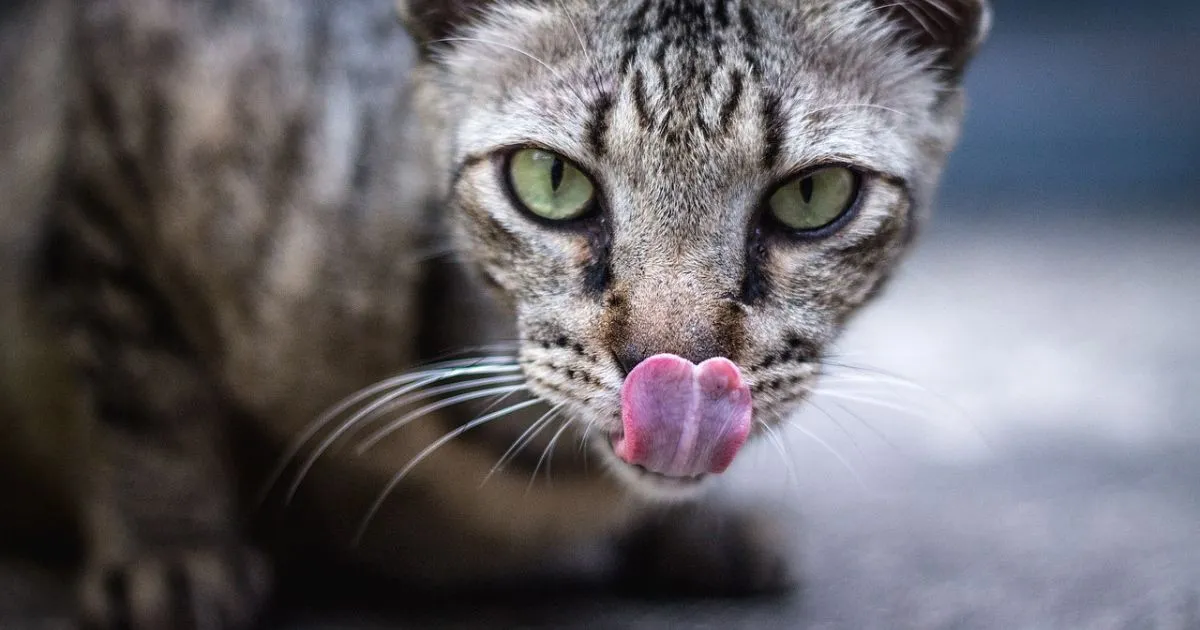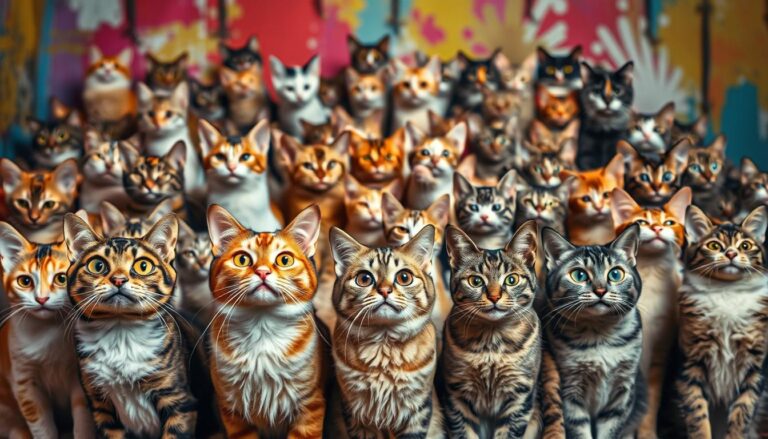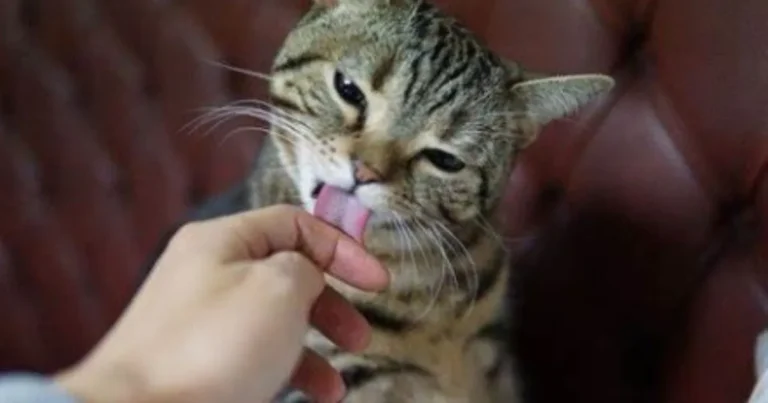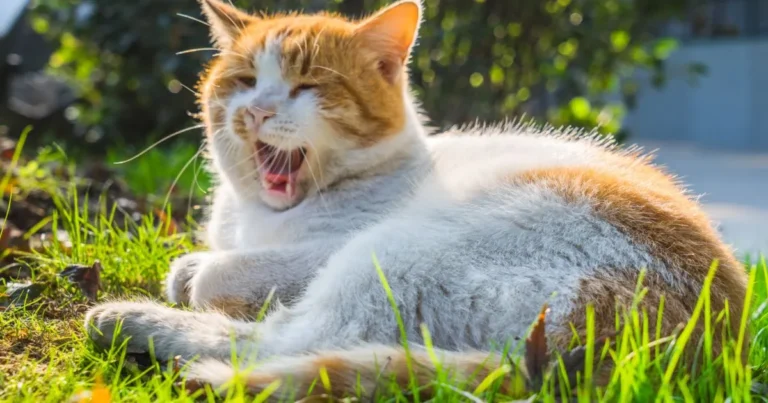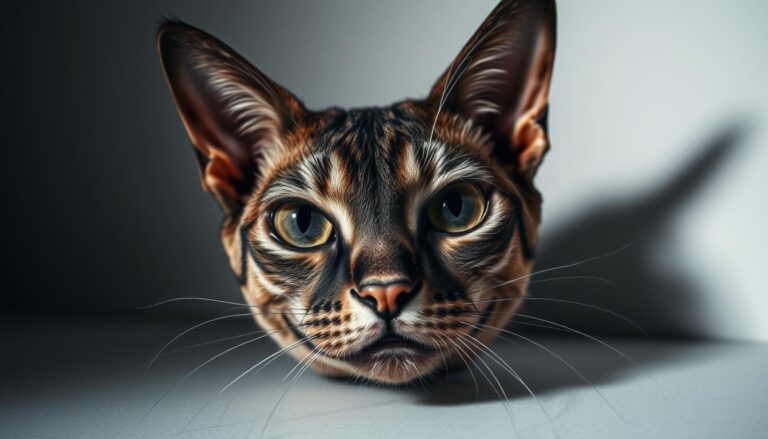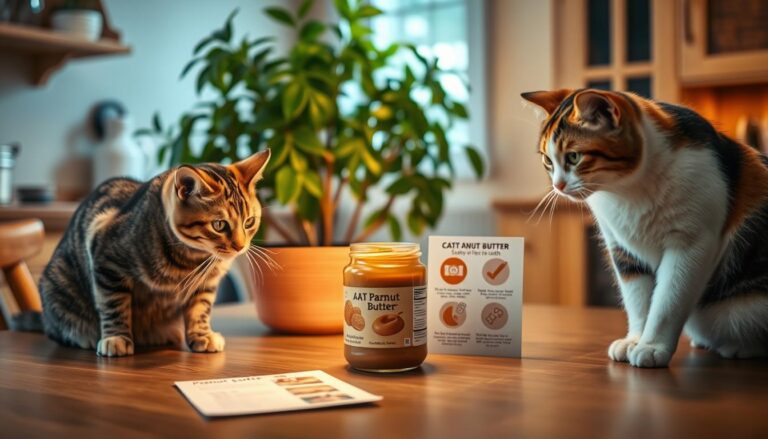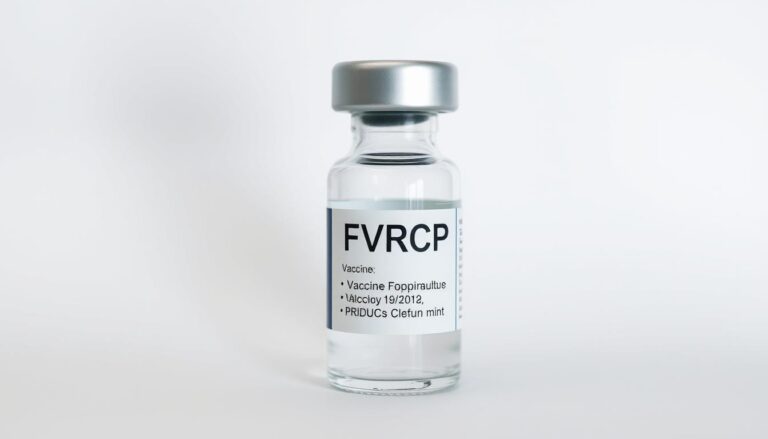What Does It Mean When My Cat Licks Me? Behavior Decoded
Table of Contents
What Does It Mean When My Cat Licks Me?
Every cat owner has felt it: when their cat starts licking them a lot. But what does it really mean? This simple act is actually a deep way for cats to communicate and show their feelings.
Cat licking is more than just a habit. It shows how much they care about you and their place in your life. It can mean they love you, are stressed, or need attention. These touches tell a story of your special bond.
Cats lick for many reasons. They might be showing love, marking their territory, or asking for attention. Knowing these reasons can change how you connect with your cat. Let’s dive into the world of cat licking and what it means.
By watching how your cat licks, you can understand them better. You’ll learn more about their feelings and needs. It’s a way to connect deeper with your cat and understand their world.
The Science Behind Cat Licking Behavior
Cats have a special way of licking that’s more than just grooming. Their tongue is designed for many tasks, not just cleaning. This shows how complex their licking behavior really is.
Feline grooming is a survival tool. It’s rooted in their biology. The cat’s tongue is a precise tool for many tasks.
Understanding Tongue Anatomy
A cat’s tongue has special parts called papillae. These tiny, backward-facing keratin projections do several important jobs:
- Removing dirt and debris from fur
- Detangling hair during self-cleaning
- Distributing natural skin oils evenly
- Regulating body temperature
Papillae: Nature’s Grooming Masterpiece
These tiny hooks work like a brush. They help cats stay clean. They also play a role in cat communication, showing social bonds and territory.
Chemical Signals and Hormonal Responses
When cats lick, they send out chemical signals. These signals share their emotional state and social info. Their saliva has pheromones that tell about their health, mood, and surroundings.
Knowing this science makes us see cat licking in a new light. It’s not just a simple action. It’s a complex way of communicating.
What Does It Mean When My Cat Licks Me?
Figuring out why your cat licks you can open up a world of understanding. Cats use licking to connect and share feelings. It’s a complex way of saying “I care about you.”
Learning about cat body language helps you grasp the true meaning of their licks. These actions are not just random. They often carry deep emotions.
- Sign of affection: Your cat sees you as family.
- Marking territory: They share their scent with you.
- Stress relief: Licking helps them calm down.
- Seeking attention: It’s their way of saying “Hey, talk to me!”
Different licking styles mean different things. A slow, gentle lick shows trust and comfort. But quick or forceful licks might mean they’re stressed or excited.
| Licking Type | Potential Meaning | Emotional Context |
|---|---|---|
| Soft, Rhythmic Licks | Deep Affection | Feeling Safe and Secure |
| Quick, Repetitive Licks | Potential Stress | Seeking Comfort |
| Prolonged Licking | Territorial Marking | Claiming Social Bond |
Getting to know these signals can make your bond with your cat stronger. By watching for context and body language, you’ll better understand their feelings.
Affection and Bonding Through Licking
Cats show their love in special ways, like licking. This act is more than just grooming. It’s a deep way for cats to connect with us.
This behavior starts early in a cat’s life. Kittens lick their mothers for many reasons:
- Cleaning and hygiene for newborn kittens
- Providing comfort and security
- Establishing initial social connections
Mother-Kitten Relationship Influence
Kittens learn to bond through their mother’s licking. This early experience shapes how cats interact with others. When your cat licks you, they see you as family.
Social Bonding in Cat Communities
In the wild, cats use licking to show who’s in charge. Domestic cats do the same with us. They mark us as part of their group through licking.
The Oxytocin Connection
Research shows that cat licking releases oxytocin, the “love hormone”. This hormone makes us feel closer to our cats. It strengthens our emotional bond.
“Licking is more than just a physical action—it’s a complex emotional communication between cats and their loved ones.”
Territorial Marking Through Licking
Cats have their own ways of talking, and it’s not just meows and purrs. They use licking as a way to mark their territory.
When your cat licks you, it’s more than just showing love. They’re leaving their scent on you. This tells other cats that you’re part of their group.
- Saliva contains unique scent markers specific to each cat
- Licking transfers these chemical signals onto your skin
- Other cats can detect these territorial markers
Licking is a natural behavior for cats. Their tongues have special glands that release pheromones. These pheromones act like invisible tags that show who owns the territory.
| Territorial Marking Method | Purpose | Effectiveness |
|---|---|---|
| Licking | Scent transfer | High |
| Rubbing | Marking surfaces | Medium |
| Scratching | Visual and scent marking | Low |
Understanding this behavior helps you appreciate the complex social world of your feline companion. Each lick is a communication signal, making you an accepted member of their territory.
The Connection Between Grooming and Communication
Cats are complex creatures with intricate communication methods. Their grooming habits are more than just cleaning. They serve as a sophisticated language of interaction and emotional expression. Understanding how cats use licking to communicate can deepen your bond and help you better interpret their needs.
Interpreting cat body language through their grooming behaviors reveals fascinating insights into their emotional world. Cats use licking as a multifaceted communication tool that extends well beyond basic cleaning.
Different Types of Licking Behaviors
Cats exhibit various licking behaviors that convey different messages:
- Affectionate licking directed at humans or other animals
- Stress-related excessive grooming
- Territorial marking through saliva
- Social bonding within cat communities
Reading Your Cat’s Body Language
Decoding feline grooming habits requires careful observation of accompanying body signals. A relaxed posture during licking indicates comfort, while tense muscles might suggest anxiety or discomfort.
| Licking Behavior | Possible Meaning |
|---|---|
| Slow, methodical licking | Relaxation and self-soothing |
| Rapid, aggressive licking | Potential stress or overstimulation |
| Licking directed at you | Affection and social bonding |
Understanding Licking Patterns
Each cat develops unique licking patterns that reflect their personality and emotional state. Careful observation helps you understand your cat’s specific communication style.
“Cats speak volumes through their grooming behaviors – you just need to learn their language.” – Feline Behavior Expert
Stress and Anxiety-Related Licking
Cat licking can show more than just love. It can also hint at stress or anxiety. When your cat licks too much, it might be trying to cope with its feelings.
Cats may lick more when they’re upset. This can be a sign of their emotional state. It’s not just about being clean; it’s a way to deal with stress.
- Sudden changes in environment
- Introduction of new pets or family members
- Disrupted daily schedules
- Loud noises or unfamiliar sounds
Spotting stress-related licking means looking for certain signs:
- Excessive self-grooming
- Persistent licking of human skin
- Compulsive licking of furniture or objects
- Visible signs of agitation
Vets suggest making your cat’s space calm. They also recommend gentle steps to ease anxiety. Things like regular routines, quiet areas, and playtime can help a lot.
If your cat’s licking is too much or seems really stressful, see a vet. A vet who knows about behavior can help figure out what’s going on.
When Licking Becomes Excessive
Cat licking can turn from normal to a health worry if it gets too much. Knowing the signs of cat licking obsession helps keep your cat safe and fix problems fast.
While some licking is okay, certain habits might mean trouble. Cat licking can mean different things when it gets too much or happens over and over.
Signs of Compulsive Behavior
Watch for these signs of too much licking:
- Constant licking of one spot
- Licking that stops your cat from doing other things
- Skin problems or hair loss from too much licking
- Your cat looks upset while licking
Health Issues to Watch For
Too much licking might show health problems:
- Skin allergies
- Parasites
- Stress or anxiety
- Brain issues
When to Consult a Veterinarian
See a vet if you notice:
- Licking that lasts more than a few days
- Changes in skin look or feel
- Behavior changes suddenly
- Pain or discomfort while licking
Acting fast can stop bigger problems and keep your cat happy and healthy.
Listen to your gut. If your cat’s licking seems off, get expert advice.
The Taste Factor: Why Cats Lick Human Skin
Exploring why cats lick us reveals a surprising aspect of the cat-human bond. It turns out, taste is a big part of it. Your cat might find your skin more interesting than you think.
Cats have unique taste preferences that go beyond their food. Your skin offers a fascinating taste experience for them. Several factors contribute to this:
- Salt from sweat: Human skin has trace amounts of salt that cats find appealing
- Lingering food residues on your hands or arms
- Skincare product flavors or scents
- Natural skin oils that attract feline curiosity
The bond between cats and humans is more than just taste. When your cat licks you, they’re experiencing a complex sensory world. Their tongue, with tiny papillae, lets them taste things we can’t.
Some cats get really interested in certain skin tastes. This is normal and comes from their natural grooming and curiosity.
While a little licking is okay, too much could mean they’re curious or have health issues. Knowing about these taste-driven behaviors helps you understand your cat better.
Managing and Responding to Cat Licking
Learning about cat communication can help you handle their licking. If your cat licks too much, it’s important to understand their body language. This way, you can respond in the right way.
Redirecting your cat’s attention is the best way to stop unwanted licking. Here are some tips:
- Give them interactive toys to keep them busy
- Use gentle physical redirection
- Provide other activities to keep them stimulated
- Create situations that distract them positively
Understanding cat body language is key to knowing why they lick. Look for these signs:
- Relaxed ears and soft eyes mean they’re happy
- Tense body posture shows stress or anxiety
- Tail position tells you how they feel
Training them to stop licking can be done with rewards. Give treats or praise when they stop licking. Being consistent is important to change their behavior.
Every cat is different. Being patient and understanding is crucial when dealing with their behavior and licking.
Building Stronger Bonds Through Understanding
Creating a strong bond with your cat takes patience and understanding. They show love in their own special ways, not just through touch. Learning these signs can change how you connect with your cat.
To connect deeply with your cat, you need to know their unique personality and habits. Understanding how they communicate helps build trust and respect between you.
Positive Reinforcement Techniques
Building a strong bond with your cat is all about positive reinforcement. Here are some tips:
- Use treats to reward good behavior
- Give gentle praise and calm interactions
- Keep routines consistent
- Respect their personal space
Creating a Balanced Relationship
A balanced relationship means knowing your cat’s emotional and physical needs. Consistency is crucial for trust and comfort.
- Watch for body language cues
- Learn what signals they prefer
- Provide interesting things to do
- Keep up with vet visits
Alternative Ways to Show Affection
Cats show love in different ways. Some like to play, while others prefer quiet time. Try different things to see what your cat likes best.
Patience and genuine understanding are the cornerstones of a lasting cat-human relationship.
Safe Practices When Your Cat Licks You
Cat licking is a natural way for them to groom themselves. But, it’s important for pet owners to know the health risks. Your cat’s mouth has many bacteria that can cause infections if they get into open wounds or mucous membranes.
While cat licking can be a sign of affection, it’s crucial to be safe. Here are some guidelines to keep you healthy while still enjoying your cat’s company:
- Wash your hands after your cat licks you
- Avoid letting cats lick open cuts or wounds
- Clean any areas where your cat has licked thoroughly
- Check for any skin irritations after frequent licking
Knowing the risks doesn’t mean you should stop your cat from showing affection. Moderate and mindful interaction is the key. This way, you can enjoy your cat’s licking without worrying about your health.
| Cat Licking Risk Factors | Recommended Actions |
|---|---|
| Open wounds | Prevent direct contact, clean immediately |
| Compromised immune system | Consult healthcare professional |
| Frequent saliva contact | Practice regular hygiene |
Your vet can give you advice on grooming habits and health concerns. They can consider your cat’s breed and health status.
Conclusion
When your cat licks you, it opens up a world of feline communication. The bond between you and your cat is more than just physical. Each lick can mean different things, like showing love or marking territory.
Your cat’s licking is a special language that shows their feelings and needs. By understanding these signals, you can get closer to your cat. Knowing why they lick helps you connect better.
By learning to read these signs, you can create a better space for your cat. Whether it’s for comfort, stress relief, or love, each lick has a story. These moments are chances to grow closer and understand your cat’s feelings.
Finally, cat licking shows how smart and emotional these animals are. By being curious and respectful, you can have a deeper bond with your cat.

